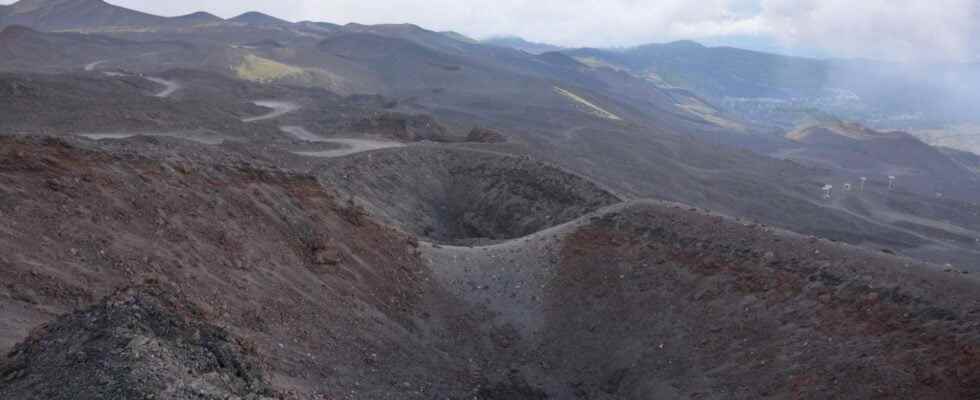A study of volcanic deposits in Danish sediments recently showed that a gigantic explosive eruption took place 55 million years ago in the middle of the North Atlantic, propelling a phenomenal amount of ash into the atmosphere. It would be one of the most powerful explosive eruptions known and documented to date.
You will also be interested
[EN VIDÉO] How does magma form before a volcanic eruption? Magma is the origin of the formation of volcanoes. This molten rock, which bubbles up in the crater, comes from a partial melting of the Earth’s mantle. Futura met Jacques-Marie Bardintzeff, doctor in volcanology, who tells the origin of magma.
It is well known, the volcanoes can be of different types and lead to styles very different eruptions. There are two main styles of volcanic eruptions: so-called effusive eruptions and so-called explosive eruptions.
Composition of lavas and eruptive styles
This diversity is linked to the chemical composition of the puddles and in particular their content of silica. Magmas low in silica will be relatively fluid and will produce large lava flows, typical of effusive volcanoes, also called “basaltic”. Etna is a well-known example. Conversely, silica-rich magmas will behave more viscous. The gas contained in the lava will have more difficulty escaping, creating an overpressure ending in an explosion throwing large quantities of ash and volcanic debris into the atmosphere. This is the case of the Mount Pelee in the West Indies. This last type of volcano is particularly dangerous compared to the more predictable basaltic effusive volcanoes.
One exception all the same: when basaltic lava comes into brutal contact with water, this can lead to an explosive reaction. We then speak ofexplosive eruption hydromagmatic. A recent example is the now well-known eruption of the Icelandic volcano Eyjafjallajökull in 2010, which produced an ash plume that disrupted air flights over the whole of Europe for several days. The explosive nature of this eruption and the large amount of ash contained in the plume was caused by the interaction between magma and water from the glacier covering the volcano.
A major hydromagmatic eruption 55 million years ago
In recent study, from geologists from the University of Oslo, Ella Stokke and Morgan Jones, were interested in levels of ash from basaltic volcanic eruptions preserved in sediment exhibited on the island of Fur in northern Denmark. These very thick volcanic deposits (up to 16 centimeters), dated 55 million years ago, contain all the physiquo-chemical characteristics allowing them to be associated with a volcanism hydromagmatic type explosive.
These ashes appear to have been produced during an eruptive event associated with the North Atlantic Igneous Province. This magmatic province covers an estimated area of 1.3 million square kilometers in the North Atlantic and is thought to have been active between 60.5 and 54.5 million years ago. Following the opening of the Atlantic and the separation continental plates, the relics of this immense magmatic province are currently found in the mountains of northwestern Scotland, the Faroe Islands and in eastern Greenland. At the time of the eruption, the volcanic source was more than 700 kilometers away from present-day Denmark where the deposits of the ash plume were found. The numerical simulations show that the plume must have reached an altitude of 30 kilometers for the ash to settle at such a great distance. It would be by far the largest hydromagmatic explosive eruption from basaltic volcanism. The only other known eruptions having allowed the transport of such large volumes of ash over such a distance are all associated with eruptions of silica-rich lava like those of the Yellowstone volcano (USA) and those of the Toba volcano (Indonesia).
The researchers estimate that the eruption that produced the levels of ash exposed in Denmark would have mobilized a volume of 1,000 cubic kilometers of magma. This certainly represents half the volume emitted during the largest explosive eruptions of Yellowstone and Toba, but a volume 7,000 times greater than that of the hydromagmatic eruption of Eyjafjallajökull. The amount of ash propelled in the explosive plume would have been enough to cover all of Norway under 2.6 meters of ash. Many clues, in particular the very high concentration of sulphides in the vitrified volcanic debris, suggest that the eruption occurred at pressures very strong, associated with a shallow ocean environment (less than 200 meters). The hydromagmatic origin of the eruption is therefore not in doubt. This period of major volcanic activity in the North Atlantic Igneous Province indeed occurred when the Atlantic Ocean was opening up.
The documentation of the eruptive behavior of volcanoes is important to understand their impact on the environment and the weather, both in the present and during geological history. The results of this study suggest that this major eruption certainly had a significant impact on the climate of the time. If a similar eruption were to occur today, it would obviously influence the global climate.
Interested in what you just read?
.
fs12
